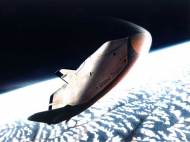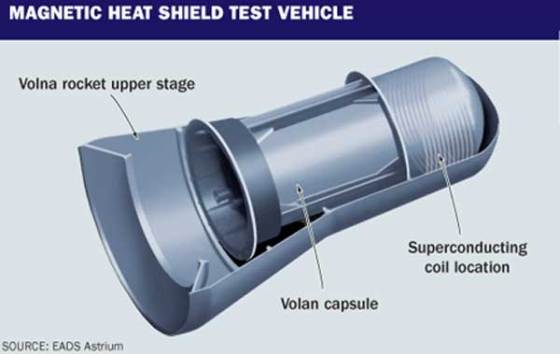Magnetic heat shields to replace ablative tiles on space shuttles?
 Heat shields are an important part of any space vehicle that re-enters the Earth’s atmosphere. The next generation of heat shields made to protect astronauts and payloads on their re-entry into the Earth’s atmosphere may use superconducting magnets to deflect the plasma that forms in front of spacecraft as they travel at high speeds in the air. The first test of such a heat shield could happen as early as ten years from now, and the basic technology is already in development. At the European air and space conference 2009 in Manchester in October, Detlev Konigorski from the private aerospace firm Astrium EADS announced such technology.
Heat shields are an important part of any space vehicle that re-enters the Earth’s atmosphere. The next generation of heat shields made to protect astronauts and payloads on their re-entry into the Earth’s atmosphere may use superconducting magnets to deflect the plasma that forms in front of spacecraft as they travel at high speeds in the air. The first test of such a heat shield could happen as early as ten years from now, and the basic technology is already in development. At the European air and space conference 2009 in Manchester in October, Detlev Konigorski from the private aerospace firm Astrium EADS announced such technology.
Under development by EADS Astrium, with support from German aerospace centre DLR and the European Space Agency, the magnetic field-protected vehicle will be launched from a submarine on a suborbital trajectory. The initial test vehicle would be launched from a submarine aboard a Russian Volna rocket on a suborbital trajectory, and land in the Russian Kamchatka region. A Russian Volan escape capsule will be outfitted with the device, and the re-entry trajectory will take it up to speeds near Mach 21.
Traditional heat shields use the process of ablation to disperse heat away from the capsule. Basically, the material that covers the outside of the capsule gets worn away as it is heated up, taking the heat with it. The space shuttle uses tough insulated tiles. A magnetic heat shield would be lighter and much easier to re-use, eliminating the cost of re-covering the outside of a craft after each entry.
A magnetic heat shield would use a superconductive magnetic coil to create a very strong magnetic field near the leading edge of the vehicle. This magnetic field would deflect the super-hot plasma that forms at the extreme temperatures cause by friction near the surface of an object entering the Earth’s atmosphere. This would reduce or completely eliminate the need for insulation or ablative materials to cover the craft.
Problems with the heat shield on a spacecraft can be disastrous, even fatal; the Columbia disaster was due largely to the failure of insulation tiles on the shuttle, due to damage incurred during launch. Such a system might be more reliable and less prone to damage than current heat shield technology.
Though the scientists are currently testing the capabilities of a superconducting coil to perform this feat, there is the challenge of calculating changes to the trajectory of a test vehicle, because the air will be deflected away much more than with current heat shield technology. The ionized gases surrounding a capsule using a magnetic heat shield would also put a wrench in the current technique of using radio signals for telemetry data.










Leave your response!